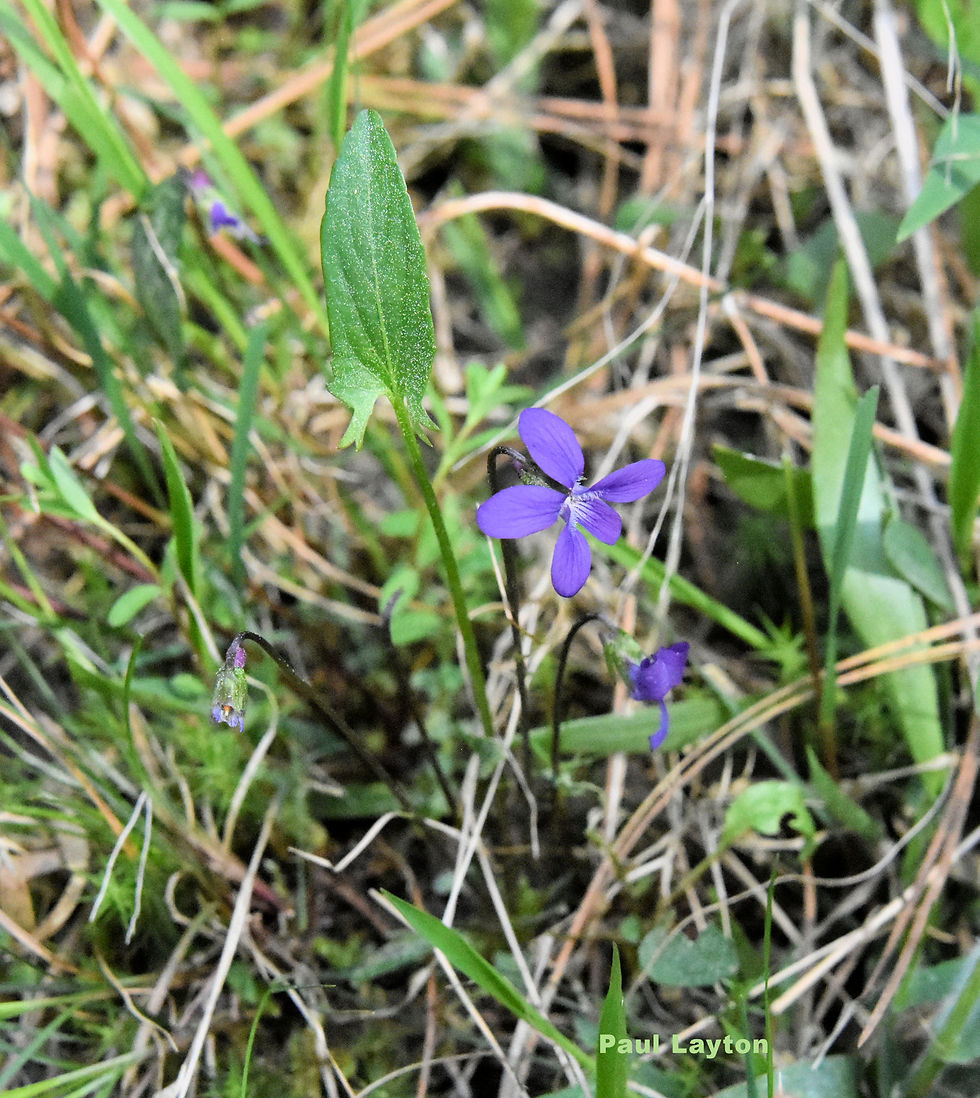Roses are Red, Violets are Yellow ???
- Paul Layton

- May 7, 2021
- 3 min read
Updated: May 8, 2021

Violets can be a challenge to identify with some species closely resembling each other. Learning the correct identity of a single species can be quite exhilarating. Quite often when walking in the forest, or over the meadow, or on side streets in more established neighborhoods where the edges of yards are less manicured, you are likely to see the Common Blue Violet in one, or both, of its color forms (see previous article). These violets were extensively planted in borders in former times and have the ability to literally take care of themselves and spread naturally. The scientific name Viola papilionacea literally means butterfly violet. Personally I feel that Butterfly Violet has a more distinguished ring to it than Common Blue Violet. Its flowers are tinted in the classic blue-violet that is generally associated with violet coloration, hence the first line of the little rhyme, “Roses are red...”.

Even when we come across the diminutive Johnny Jump-up or the little Field Pansy with flowers of pale yellow, they are usually blushed with a pale lilac tone. Also because they are so small, we may not associate them with the larger violets. Another day as you hike along a sandy trail bordered by a drainage ditch, some small upright white violets are found. With their wiry reddish flower stems (peduncles), upper two petals reflexed and purple veining on the lower lip of the corolla, they can hardly be mistaken. If you sniff them they have a lovely fragrance. This is the Primrose-leaved Violet (Viola primulifolia), proving that you can be small but perfectly beautiful.

Searching still farther along the soggy edges of streams, seeps, or vernal pools
where sedges and sphagnum tend to grow, a colony of blue violets appear with
the flowers held well above the foliage on stiff upright stems. The violet-blue
corollas are shaded darker toward the center. Only the side petals are bearded
with club-like hairs (use your hand lens). The lower petal is beardless and
somewhat shorter than the laterals. Totally at home in the boggy areas of the
forest along Johnson’s and Tantrough branch, it can sometimes be found growing
on tussocks in more open pond situations. This is the Marsh Blue Violet (Viola
cucullata).

The borders of drainage ditches in partial shade are often covered in various mosses. Hair cap, silver and sphagnum moss are likely present. Sometimes a large but scattered population of Primrose-leaved Violets can be found. Infrequently some purple violets with palmately divided leaves (like the spread fingers of your outstretched palm) might be found growing here as well. This is the Coast Violet (Viola brittoniana). Their purple corollas are whitish toward the center and all three lower petals are bearded.

Coast Violets are often confused with the similar, but much rarer Birdfoot Violet (Viola pedata) because of the similarity of their leaves. If you come across a violet with a large, flat faced, lavender corolla with no beards plus palmately divided leaves, it is the Birdfoot Violet. The tips of the yellow stamens are also visible at the center. It prefers gravelly, limey areas usually in full sunshine. Once you learn to know the Birdfoot, you will never forget it. It grows extensively along the forest service roads in the George Washington National Forest but is listed on the Delaware’s register of Rare Vascular Plants in Sussex County as class S-1 (the most endangered grouping). Both the Birdfoot and Coast Violet (class S-2) grow within the drainage area of Tantrough and Johnson’s Branch.

Because of the Birdfoot’s rarity I was walking and searching all of the trails of the Millponds Nature Preserve hoping to locate and document additional populations, when I came across a new species for me. This violet has leaves divided in three parts or fingers less deeply cut, plus all three lower petals are bearded. Be forewarned however as in our previous discussion on variability, the leaves on hairy petioles can be divided into three or sometimes five parts. To make matters even worse, when the plant emerges in the springtime the first leaves can be heart-shaped (chordate). As the plant grows larger and begins to bloom in late April or early May, the typical leaves develop (see photo). This is the Wood Violet (Viola palmata).


Another of the distinctly leaved violets is the Arrow-leaved Violet (Viola sagittata), with violet flowers and leaves that are arrow-shaped and jagged at the base.

These also seem to prefer wet sandy soil at the edges of pools, gravel roadsides, and drainage areas. A good field guide is, "A Field Guide to Wildflowers", by Roger Tory Peterson and Margaret Mc Kenny, a Peterson Field Guide Series
******************************************************************************************************************************** Editors note: Next week we will journey down the Mispillion River and visit the numerous old mills that are the reasons for the four ponds (or lakes) that remain. I was very surprised with what I learned about some of the miller owners. Steve Childers


Comments